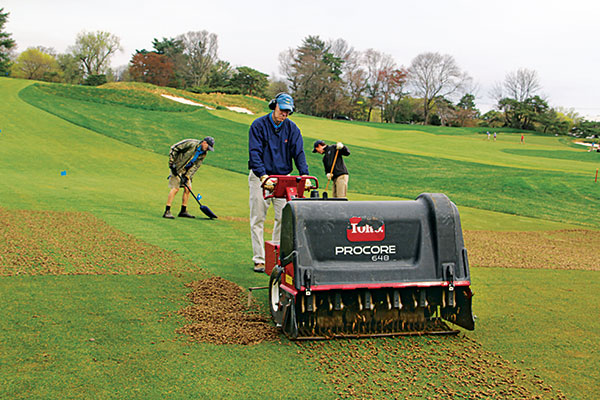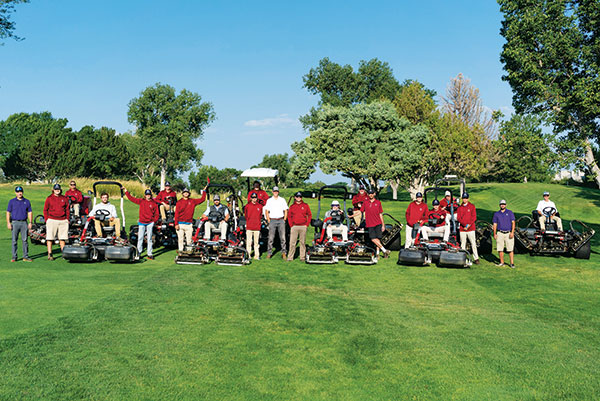Double the golf, half the workers

Photo: Golfdom Staff
What do you do when you have nearly double the normal number of rounds at your course but half the workforce to keep it in shape?
Thanks to a global pandemic, a tight-as-ever labor market and higher-paying jobs in other industries, that very situation has played out over and over again at golf courses around the country — the golfers are there, the mowers are gassed up and ready to go, but the workers are not.
Many courses are down, on average, about three to five people, according to Tyler Bloom, principal and owner of Tyler Bloom Consulting, which assists golf courses from Rhode Island to Florida in finding and keeping quality labor.
“You hear from everyone that it wasn’t an issue when they were coming up in the industry, but I think this has been going on for five to 10 years, maybe even longer,” Bloom says. “Now that other industries are struggling, it’s just more exacerbated.”
Bloom and other industry veterans discuss ways to fill the labor gap and what’s around the corner for the next nine in the golf course labor market.
Pay them and they will come
When it comes to enticing people into the golf industry, Zach Bauer, superintendent of Valley Country Club in Aurora, Colo., believes there’s a simple answer: It all comes down to money.
“I saw a sign that McDonald’s was hiring at $15 an hour. If those places are paying $15, why can’t golf pay $16 to $19 an hour?” Bauer says. “I’ve seen a lot of low pay from golf courses. Man, you just can’t do that anymore. You’re not going to be competitive at all. We need to start paying people what they’re worth and offer them a wage they can live on.”
Bauer admits that his course’s location near Denver drives up wages, but he believes courses nationwide should no longer get away with using cheap labor.
Bloom agrees, noting that clubs may need to reevaluate their current financial models, raise their member dues and reconsider their pay tiers.
“Smart businesspeople understand that the cost of business is going up, and the industry for years has gotten away with paying people pretty cheaply,” Bloom says.

A strong culture makes the crew come together when a big project or event arrives on the calendar, like aerification (Photo: Golfdom Staff)
Bloom says it’s important not to forget employees who have been working at the club for years and who already fall in the higher pay range.
“Employees in that $15 to $19 range are going to start saying, ‘What about me now?’ Clubs have to be strategic on whether they decide to give those people more responsibility to justify that level of pay,” Bloom says.
Where to find them
To bridge the labor gap, many courses seek out the up-and-coming generation.
For example, Desert Mountain GC in Scottsdale, Ariz., implemented a program where it hired the kids of parents who already worked at the golf course, so long as they were older than 15.
“It was like ‘go to work with your parents,’ and that was a very successful program for us, especially during the pandemic when kids weren’t going to school on a normal schedule,” says Shawn Emerson, former director of agronomy at Desert Mountain Club, now an industry consultant. “We just worked out programs so they could bring their kids to work and make money.”
The program of recruiting young workers expanded from there, with representatives from the golf course talking to high school and college teams about the potential career paths available at golf courses. All in all, Desert Mountain employs around 20 to 25 high schoolers seasonally.
“Always start within one set of people because if you have a workforce that enjoys working there, they’re going to tell others,” Emerson says. “We need to work together to motivate kids at the high school level that golf is a career. And then, we need to look at the pay and the wages of every position and make those livable, desirable positions.”

Valley Country Club in Aurora, Colo., has relied on the younger generation to help fill the labor gap. (Photo: Zach Bauer)
Valley CC uses a similar tactic, employing around 10 high school kids — some of them members’ kids and others from the local golf teams who also receive free golf in addition to their hourly wage. The high schoolers typically work the morning shift, putting in around six hours before heading out around noon.
“The high school golf teams have really saved us in the past couple of years. The kids do all the harder labor, so that the retirees we employ don’t have to,” Bauer says. “Also, it’s nice, because with the golf coach, we actually have someone else helping with accountability. Barely any of them are ever late to work, and they all work their butts off.”
Other potential recruiting avenues include hiring retirees part time, enlisting the help of temp agencies and hiring someone whose role mostly revolves around the recruitment process, sources say.
Give them reasons to stay
When Greg Brandriet started as the assistant superintendent at Elkhorn Ridge GC in Spearfish, S.D., in 2009, employee turnover from year one to year two came in at a whopping 70 percent.
From the time he became superintendent about a year later to 2020, turnover dropped to 5 percent overall of his full-time staff of 10.
“The more that I grew as a superintendent and grew into my role as a leader, the easier it was for me to understand what people expect and what brings loyalty out of people. You learn how to treat people like human beings,” Brandreit says. “At the end of the day, we all have families, cars that break down or alarms don’t go off.”
Elkhorn Ridge utilized a culture testing system where employees answered questions that revealed the best way to lead employees, based on their personalities.
“With millennials coming up, there’s a whole new playbook as far as what managers and superintendents have to do and understand what their mindset is,” Brandreit says. “I think it’s being flexible and being adaptive to managing different people in different ways. With the younger generation, I think that’ll be key in retaining and attracting workers to the golf course in the future.”
Brandreit says initiatives such as employee of the week, employee barbecues and a companywide round of golf at another local course helped sustain the type of culture where people feel they belong.
Overall, the efforts paid off — especially when it came to managing the course during the pandemic.
“Our staff was cut in half, but we were twice as busy. We were putting out a product that was just as good if not better with half the people because they all sensed that they needed to step up,” Brandreit says. “The way we treated them got them to buy into the system we were running.”
Flexible scheduling also serves as a plus for potential employees, according to Chad Carpenter, superintendent of the 27-hole Forest Park GC in St. Louis, Mo.
“It’s not the highest-paying industry in our country, but flexibility is one of the key perks,” Carpenter says. “The crew knows when we have big functions and they come together, but when it’s business as usual, they can be flexible about when they want time off with their families.”
Retention bonuses, tuition reimbursement and more paid time off can sweeten the deal even further, but no matter what methods a course employs, Bloom says it’s important to always keep its biggest asset — the people — top of mind.
“Superintendents and general managers have to be advocates for their teams, instead of lamenting people not showing up for work or not getting anyone in for interviews,” Bloom says. “Sometimes it’s just acknowledging them, a pizza party or new work uniforms, but don’t forget about the people who are keeping your business alive and make sure you take care of them.”
More insight: Make their jobs more efficient
To keep the maintenance ball rolling, Forest Park GC in St. Louis, Mo., cross trains staff on everything related to course setup.
“Everyone has to be able to do everything except for equipment technician and spray technician, as far as course setup,” says Chad Carpenter, superintendent.
At Elkhorn Ridge GC in Spearfish, S.D., employees found shortcuts such as attaching blowers to the back of greens mowers and doubling up on jobs such as raking bunkers and cleaning bathrooms in one pass, according to Greg Brandriet, former superintendent.
Shawn Emerson, former director of agronomy at Desert Mountain GC, notes that technology such as soil moisture meters, autonomous equipment and wide-area mowers help pick up the slack.
The course also looked to drone technology for immediate feedback on course conditions so that problems could be solved quicker and GPS technology to determine where turf could be removed in nonplay areas.
“We used the GPS systems to see where the golfers were really playing the golf course from and finding out what acreage could be reduced,” Emerson says. “A lot of it was on the sides of the golf course, or the first 100, 150 yards off the tees.”











